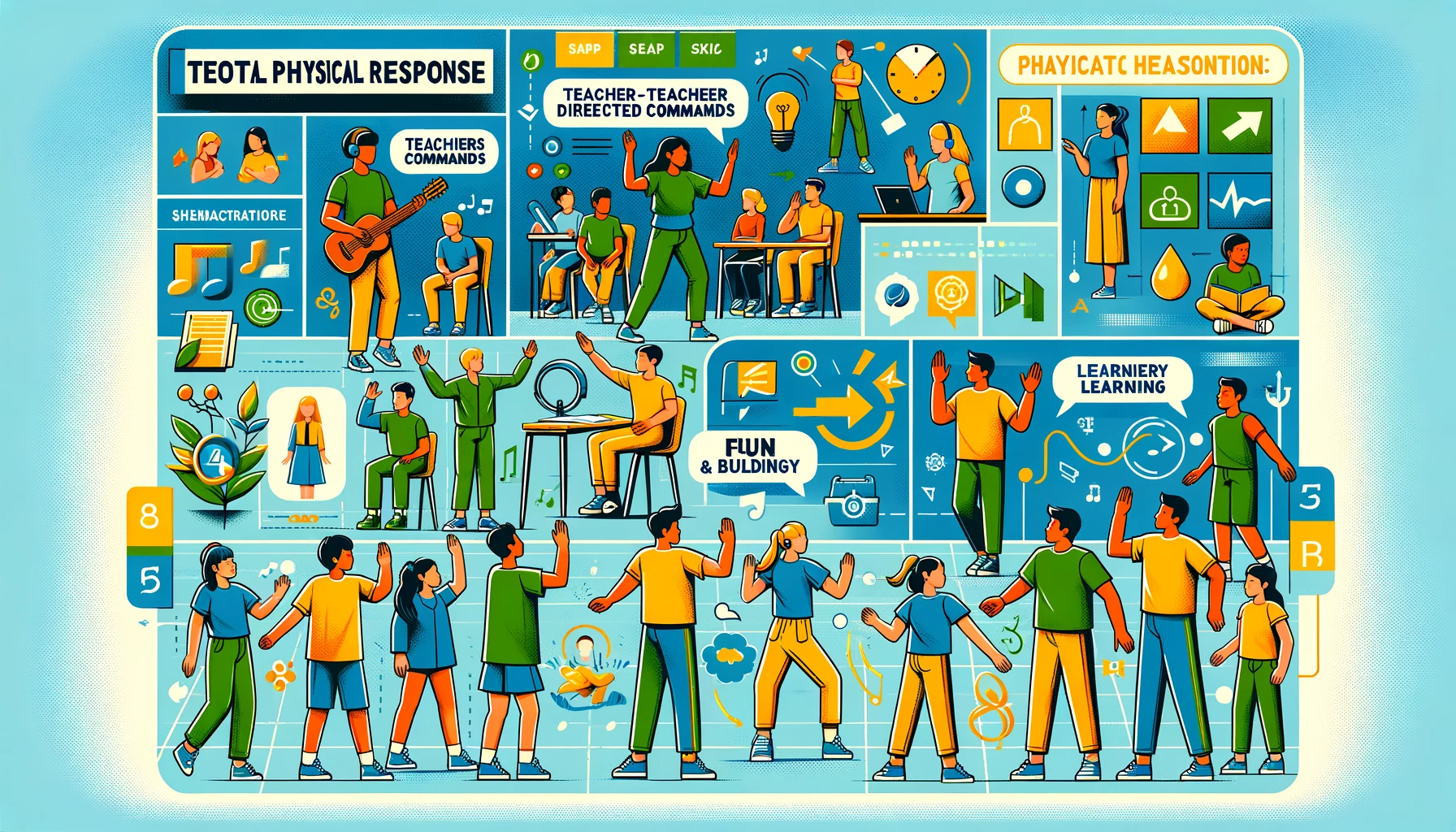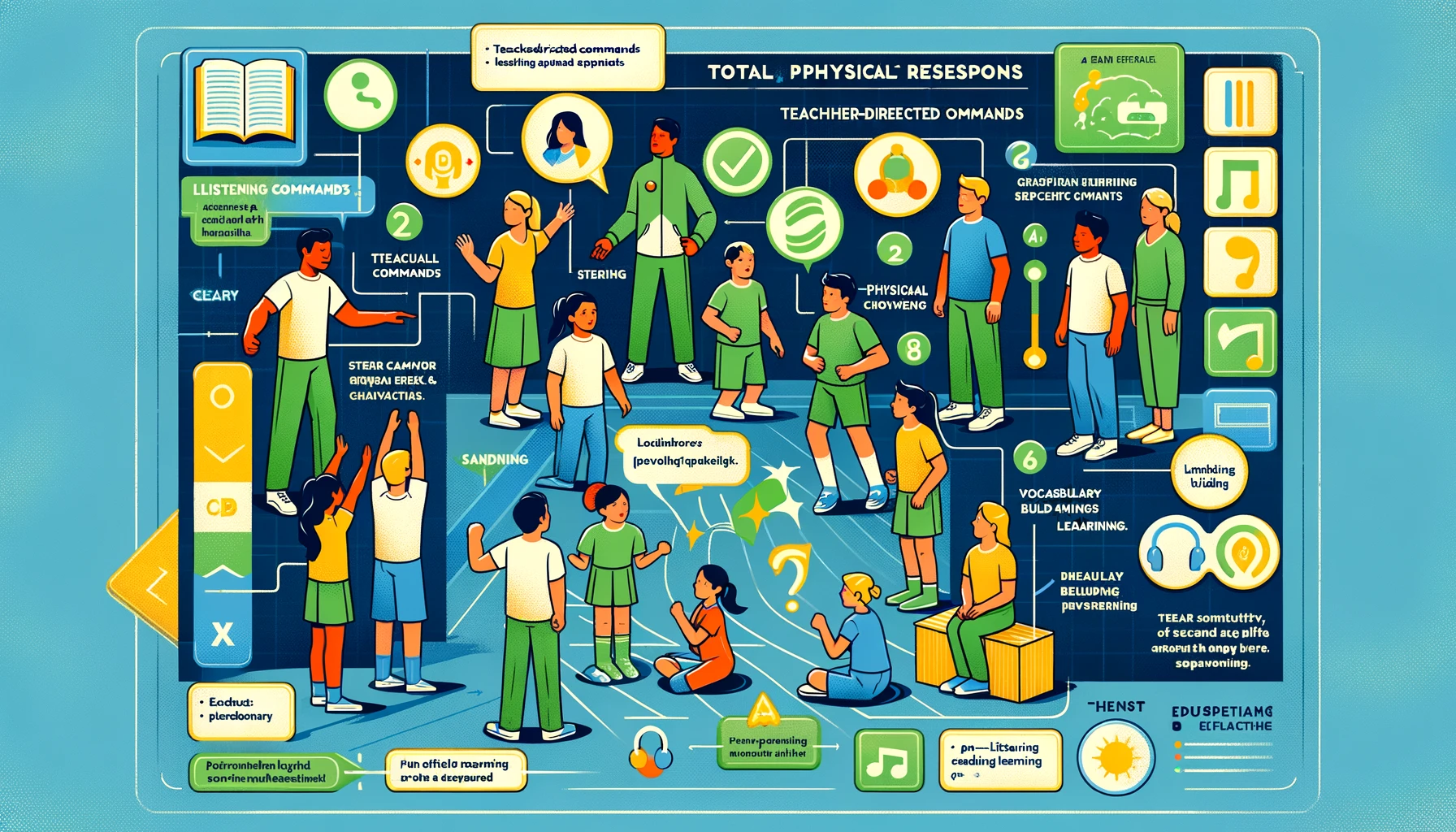Discover the characteristics and benefits of the Total Physical Response method in language teaching. Enhance listening comprehension and overall language acquisition through the power of physical movement.
The method we will consider now is an example of a new general approach to foreign language instruction which has been named “the comprehension approach”. It is called this because of the importance it gives to listening comprehension. All the other methods we have looked at have students speaking in the target language from the first day. Methods consistent with the comprehension approach, on the other hand, begin with the listening skill. ‘
The idea of focusing on listening comprehension during early foreign language instruction comes from observing how children acquire their mother tongue. A baby spends many months listening to the people around it long before it ever says a word. The child has the time to try to make sense out of the sounds it hears. No one tells the baby that it must speak. The child chooses to speak when it is ready.
What is the Total Physical Response Method?
The Total Physical Response language teaching method developed by James Asher, Professor of Psychology at San Jose State University, California, attempts to teach language through physical (motor) activity.
Asher sees successful adult second language learning as a parallel process to child first language acquisition, and in that it is a Natural Method. He claims that speech directed to young children consists primarily of commands, which children respond to physically before they begin to produce verbal responses, and this led him to view the verb in the imperative as the central linguistic motif around which language use and learning are organized. Asher states that “most of the grammatical structure of the target language and hundreds of vocabulary items can be learned from the skillful use of the imperative by the instruction.
10 Characteristics Of Total Physical Response Method.

Response (TPR) is derived mainly from three influential learning hypotheses.
(Richards and Rodgers 1986 : 88)
- There exists a specific innate bio-programmed for language learning.
- Brain lateralization defines different learning functions in the left and right brain hemispheres.
Stress (an affective filter) intervenes between the act of learning and what is to be learned; the lower the stress, the greater the learning.
- The bio-programmed.
Asher sees first and second language learning as parallel processes, and the three processes which he considers as central are :
- Children develop listening competence before they develop the ability to speak. During this period of listening the learner may be making a mental blue print of the language that will make it possible to produce spoken language later.
- Children’s ability in listening comprehension is acquired because children are required to respond physically to spoken language in the form of parental commands.
- Once a foundation in listening comprehension has been established, speech evolves naturally and effortlessly out of it.
Asher bases these assumptions on his belief in the existence in the human brain of a bio-programme for language.
“A reasonable hypothesis is that the brain and nervous system are biologically programmed to acquire language….in a particular sequence and in a particular mode. The sequence is listening before speaking and the mode is to synchronize language with the individual’s body” (Asher 1977 : 4).
- Brain Lateralization
Asher sees Total Physical Response as directed to right brain learning, whereas most second language teaching methods are directed to left-brain learning. Drawing on work by Jean Piaget, Asher holds that the child language learner acquires language through motor movement –a right hemisphere activity. Language activities are centralized in the right hemisphere. Right-hemisphere activities must occur before the left hemisphere can process language for production.
- Reduction of Stress
An important condition for successful language learning is the absence of stress. According to Asher, first language acquisition takes place in a stress-free environment, whereas the adult language environment often causes stress and anxiety. Teacher’s job, therefore, is to liberate the learner from self-conscious and stressful situations so that he is able to devote full energy to learning. And this can be accomplished by focusing on meaning interpreted through movement, rather than on language forms studied in the abstract. Grammar is thus taught inductively.
Learning/teaching activities :
Imperative drills are the msyor classroom activity in Total Physical Response. They are typically used to elicit physical actions and activity on the part of the learners. Other classroom activities include role plays such as at the restaurant, super-market or railway enquiry counter.
Learner/teacher roles :
Learners in Total Physical Response have the primary roles of listener and performer. They listen attentively and respond physically to commands given by the teacher, learners have little influence over the content of learning, since content is determined by the teacher, who follows the imperative-based, format for reasons.
The teacher plays an active & direct role in Total Physical Response. “The instructor is the director of a stage play in which the students are the actors”(Asher, 1977: 43)
The teacher’s role is not so much to teach as to provide opportunities for learning. The teacher has the responsibility of providing the best kind of exposure to language so that the learner can internalize the basic rules of the target language. Thus the teacher controls the language input the learners receive.
Teaching materials and procedure . There is generally no basic text in a Total Physical Response course. Pictures realia, slides and word charts play important role.
Asher (1977) provides a lesson-by-lesson account of a course taught according to TPR principles. Some of the imperatives that feature in.the lesson are as follows :
Jeff, throw the red flower to Maria.
Saman, pick up the knife soon and put them m the cup.
Ahmad, take a drink of water and give the cup to Saman.
Toothbrush — Take out your toothbrush
Brush your teeth
Put your toothbrush in your book
Towel — Put the towel on Ahmadi’s arm.
Ahmad, put the towel on your head and laugh
Saman wipe your hands on the towel.
Total Physical Response (TPR) is a language teaching method developed by James Asher, a psychology professor at San José State University. It is based on the coordination of language and physical movement. In TPR, instructors give commands to students in the target language, and students respond with physical actions.
Here’s a guide to the Total Physical Response Method in a tabular format:
| Step | Description |
|---|---|
| 1. Preparation | The teacher prepares a list of commands that students can physically respond to. These commands should be in the target language and appropriate for the students’ proficiency level. |
| 2. Demonstration | The teacher demonstrates each command while saying it. Students watch and listen without speaking. |
| 3. Student Participation | Students begin to perform the actions in response to the teacher’s commands. The teacher continues to demonstrate and assist as needed. |
| 4. Role Reversal | Once students are comfortable, they can take turns giving commands to the class or to each other. |
| 5. Adding Complexity | Gradually, the teacher introduces more complex commands and sequences of actions. This can also include storytelling where actions are part of the narrative. |
| 6. Speaking Practice | Eventually, students start to say the commands as they perform the actions, leading to more active speaking practice. |
| 7. Assessment | The teacher informally assesses students’ comprehension and participation. Corrections are made in a supportive and non-threatening manner. |
| 8. Expansion | The method can be expanded to include other activities such as role plays, games, and problem-solving tasks that incorporate the physical response element. |
This method is particularly effective for beginners and for acquiring essential vocabulary and sentence structures. It reduces student stress, as they don’t need to speak until they feel ready, and it can be a fun and engaging way to learn a new language.
Conclusion
Total Physical Response has enjoyed some popularity because of its support by those who emphasize the role of comprehension in second language acquisition. Krashen (1981), for example, regards “comprehensible input” and “reduction of stress” as keys to successful language acquisition, and he sees performing physical actions in the target language as a means of making input comprehensive and minimizing stress. One serious limitation of the TPR method is that it typically deals with only the very beginning stages of learning. Proponents of Communicative Language Teaching would question the relevance to real world learner needs of the TPR syllabus and the utterances and sentences used within it. The TPR method should be. however, used, as Asher also suggests, in association with other methods and techniques
